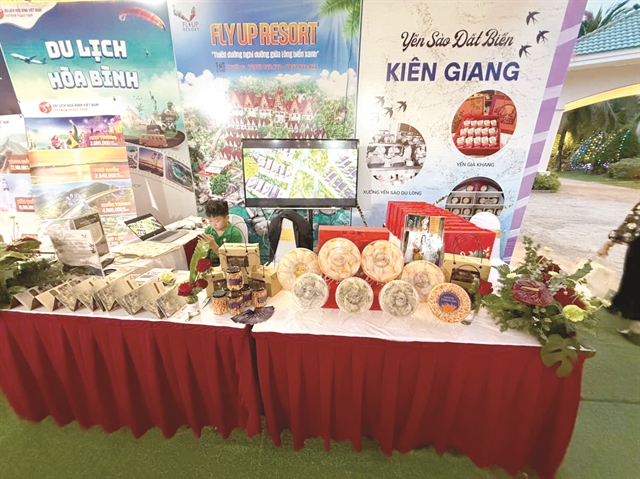Weather:
- Ha Noi 29oC
- Da Nang 29oC
- Ho Chi Minh 27oC

Despite leading the country in terms of edible bird's nest production, Kiên Giang Province has yet to capitalise on its full potential in official export markets.
Known for its high-quality edible bird's nests [or yến sào in Vietnamese] and favourable ecological conditions, the province is well-positioned to become a key player in the global edible bird's nest industry.
However, to turn that potential into sustainable trade, the local producers must adopt international standards, improve coordination, and build a reputable brand.
Speaking to Việt Nam News, Trần Quốc Phương, vice chairman of the Kiên Giang Edible Bird's Nest Association, shared insights into the industry’s comparative advantages, the steps needed to enter global markets, and the challenges that must be addressed along the way.
Why is Kiên Giang positioned at the forefront of the country's edible bird’s nest industry?
Kiên Giang possesses a range of natural and strategic conditions that are ideal for edible-nest swiftlet farming. The province has a long coastline, dense tropical forests, and over a hundred islands. This diverse environment creates an ideal habitat for swiftlet, or swallows, to nest and thrive.
The mild, year-round tropical climate contributes significantly to the growth of insect populations — the primary food source for the birds — while vast agricultural and aquacultural lands further enrich the local ecosystem.
In comparison with other provinces like Bạc Liêu or Khánh Hòa, or even with regional competitors such as Indonesia and Thailand, Kiên Giang not only has a higher number of swiftlet-raising houses but also offers greater ecological diversity. This gives the province a natural advantage in both productivity and long-term sustainability.
What must Kiên Giang do to gain a foothold in global export markets?
To penetrate these markets, the province must standardise its entire production chain. From constructing birdhouses and harvesting nests, to processing, packaging and exporting — every step must comply with strict food safety and traceability standards.
International certifications such as HACCP, ISO 22000, and GMP are no longer optional, but essential. Without meeting these standards, it will be impossible to compete internationally.
Equally important is the development of a strong brand identity. "Yến sào Kiên Giang" is already recognised for its quality domestically. What is lacking is a unified, export-oriented branding strategy. The products must be traceable, certified, and consistently high-quality to earn consumer trust abroad.
To achieve this, I advocate for stronger collaboration across the supply chain. Building cooperatives and linking farmers with processors and exporters would help stabilise prices, eliminate counterfeit products, and improve overall efficiency.
What challenges are hindering the growth of Kiên Giang’s edible bird's nest industry?
One major issue is the spontaneous and unregulated construction of birdhouses, especially in urban areas. These developments cause noise pollution, create tension in communities, and disrupt urban planning.
The uncontrolled building of birdhouses has led to oversupply and weakened the living habitat for swiftlet. More birdhouses do not always mean more edible nests. In fact, it can fragment the population and reduce nest yield.
The industry also remains largely fragmented. Most producers work individually, without sufficient technical support or market access. As a result, quality is inconsistent, prices fluctuate wildly, and traceability becomes difficult.

What solutions are needed to ensure long-term sustainability?
First, farming techniques must be modernised. Learning from countries like Malaysia and Indonesia can help increase yield while maintaining ecological balance.
Proper harvesting practices are also critical. Nests must be collected at the right time, and handled with care to retain their nutritional value and meet hygiene requirements.
Training is another vital component. Regular workshops and seminars for both farmers and processors should be supported by local authorities and the Kiên Giang Edible Bird's Nest Association.
Policy-wise, zoning regulations are urgently needed. It is necessary to define where birdhouses can and cannot be built to avoid conflicts with residential area planning and ensure proper oversight.
Greater investment in processing facilities is also necessary. To meet export standards, the province must develop modern, large-scale processing facilities capable of handling everything from cleaning to packaging in a hygienic, certified environment.
Is Kiên Giang ready to rise as a global brand?
The global market for edible bird's nests is valued at US$5 billion annually. While Việt Nam has the potential to claim a larger share, success will depend on how quickly provinces like Kiên Giang can transition from raw production to refined, traceable, export-ready supply chains.
Kiên Giang is ready. But vision, discipline, and strategic cooperation are essential. If the province invests wisely now, it can emerge as the leading edible bird's nest hub of the Mekong Delta — and a trusted name in the international marketplace.
What is Kiên Giang’s roadmap for the 2025–2030 period?
Looking ahead, Kiên Giang is not only aware of its natural advantages but is also laying the groundwork to turn potential into sustained economic value. As part of its agricultural restructuring agenda, the province has set out a strategic vision for the edible bird's nest industry for the 2025–2030 period, aiming to elevate it into a high-value, export-oriented economic sector.
At the heart of this vision is the commitment to sustainable development. The province plans to implement a comprehensive zoning system to manage the construction and location of birdhouses, ensuring harmony with urban planning and environmental protection. Alongside this, efforts are underway to register a provincial geographical indication for "Yến sào Kiên Giang" — a move designed to enhance brand recognition and protect product authenticity.
Investments will also be directed toward improving post-harvest processing.
By 2027, the province targets the establishment of at least two certified processing centres that meet international food safety standards such as HACCP and ISO 22000.
These facilities will help shift the industry from raw nest production to value-added export goods, reducing dependence on unofficial trading channels. VNS


